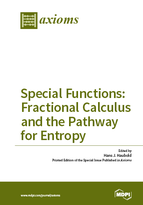Special Functions: Fractional Calculus and the Pathway for Entropy Dedicated to Professor Dr. A.M. Mathai on the occasion of his 80th Birthday
A special issue of Axioms (ISSN 2075-1680).
Deadline for manuscript submissions: closed (28 April 2017) | Viewed by 87360
Special Issue Editor
2. Centre for Mathematical and Statistical Sciences, Peechi Campus, KFRI, Peechi, Kerala 680653, India
Interests: special functions; fractional calculus; entropic functional; mathematical physics; applied analysis; statistical distributions; geometrical probabilities; multivariate analysis
Special Issues, Collections and Topics in MDPI journals
Special Issue Information
Dear Colleagues,
This Special Issue of Axioms is an attempt to capture the broad spectrum of scientific endeavors of Professor Dr. A.M. Mathai at the occasion of his anniversary.
A.M. Mathai was born on 28 April 1935 in Arakulam, near Palai, in the Idukki district of Kerala, India as the eldest son of Aley and Arakaparampil Mathai. After completing his high school education in 1953 from St. Thomas High School, Palai joined St. Thomas College, Palai with record marks and obtained his B.Sc. degree in Mathematics in 1957. In 1959, he completed his Master's Degree in Statistics from the University of Kerala, Thiruvananthapuram, Kerala, India; he was first in class, and achieved the first rank and a gold medal. Then, he joined St. Thomas College, Palai, University of Kerala, as a Lecturer in Statistics and served there until 1961. He obtained a Canadian Commonwealth scholarship in 1961 and went to the University of Toronto, Canada to complete his M.A. degree in Mathematics in 1962. He was awarded a Ph.D. from the University of Toronto, Canada in 1964. Then, he joined McGill University, Canada as an Assistant Professor until 1968. From 1968 to 1978, he was an Associate Professor there. He became a Full Professor of McGill in 1979 and served the Department of Mathematics and Statistics until 2000. He is also the founder of the Canadian Journal of Statistics and the Statistical Society of Canada. As of this date, A.M. Mathai is an Emeritus Professor of Mathematics and Statistics at McGill University, Canada, and Director of the Centre for Mathematical and Statistical Sciences, India. He has published over 300 research papers and more than 25 books on topics in mathematics, statistics, physics, astrophysics, chemistry, and biology. He is a Fellow of the Institute of Mathematical Statistics, National Academy of Sciences of India, President of the Mathematical Society of India, and a Member of the International Statistical Institute.
He was instrumental in the implementation of the United Nations Basic Space Science Initiative (1991-2012).
Prof. Dr. Hans J. Haubold
Guest Editor
Manuscript Submission Information
Manuscripts should be submitted online at www.mdpi.com by registering and logging in to this website. Once you are registered, click here to go to the submission form. Manuscripts can be submitted until the deadline. All submissions that pass pre-check are peer-reviewed. Accepted papers will be published continuously in the journal (as soon as accepted) and will be listed together on the special issue website. Research articles, review articles as well as short communications are invited. For planned papers, a title and short abstract (about 100 words) can be sent to the Editorial Office for announcement on this website.
Submitted manuscripts should not have been published previously, nor be under consideration for publication elsewhere (except conference proceedings papers). All manuscripts are thoroughly refereed through a single-blind peer-review process. A guide for authors and other relevant information for submission of manuscripts is available on the Instructions for Authors page. Axioms is an international peer-reviewed open access monthly journal published by MDPI.
Please visit the Instructions for Authors page before submitting a manuscript. The Article Processing Charge (APC) for publication in this open access journal is 2400 CHF (Swiss Francs). Submitted papers should be well formatted and use good English. Authors may use MDPI's English editing service prior to publication or during author revisions.
Keywords
- special functions
- fractional calculus
- entropic functional
- mathematical physics
- applied analysis
- statistical distributions
- geometrical probabilities
- multivariate analysis





